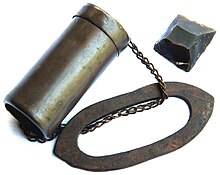Tinderbox
[1] This was simply a piece of carbon steel (it is difficult to obtain sparks with ordinary iron), which was usually wrought into a 'D' shape, or an oval ring, so that it could be conveniently looped around two or three fingers for striking.
[2] The charcloth was fabric made from vegetable fibre (e.g. cotton, linen, or jute) which had previously been charred via pyrolysis, giving it the low ignition temperature and slow burning characteristics suitable for use as tinder.
The sparks (actually pieces of burning steel broken off by the harder flint) created very small embers as they fell onto the charcloth, the glow of which, with some gentle blowing, would be enough to ignite a sulfur tipped wooden splint.
[5] When away from home small pocket tinderboxes were often carried, sometimes set with a burning glass (a magnifying lens) in the lid to light the tinder directly from the sun's rays.
In the early 19th century a more efficient tinderbox was invented with a rotating metal wheel to create the sparks[4] and there were other more experimental devices available, such as the fire piston and the instantaneous light box.



